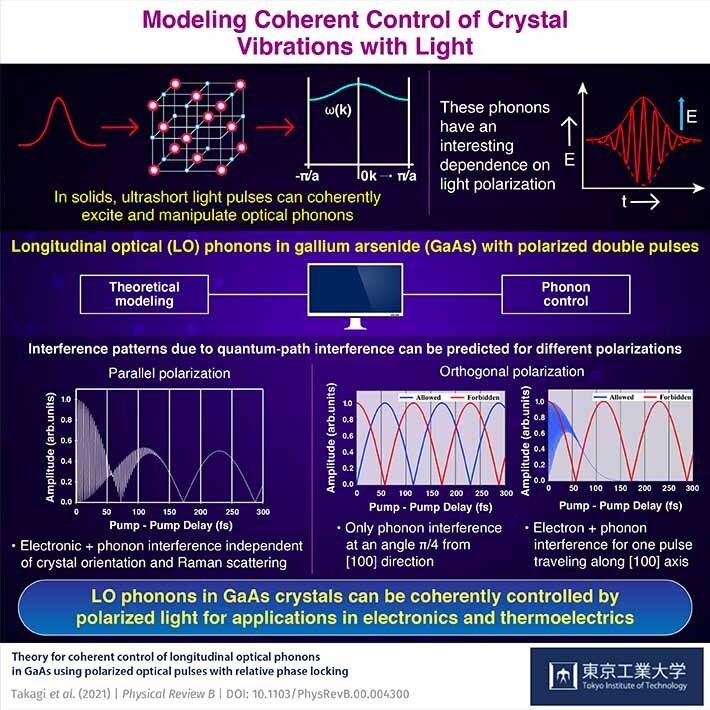The quantum behavior of atomic vibrations excited in a crystal using light pulses has much to do with the polarization of the pulses, say materials scientists from Tokyo Tech. The findings from their latest study offer a new control parameter for the manipulation of coherently excited vibrations in solid materials at the quantum level.
To the naked eye, solids may appear perfectly still, but in reality, their constituent atoms and molecules are anything but. They rotate and vibrate, respectively defining the so-called “rotational” and “vibrational” energy states of the system. As these atoms and molecules obey the rules of quantum physics, their rotation and vibration are, in fact, discretized, with a discrete “quantum” imagined as the smallest unit of such motion. For instance, the quantum of atomic vibration is a particle called “phonon.”
Atomic vibrations, and therefore phonons, can be generated in a solid by shining light on it. A common way to do this is by using “ultrashort” light pulses (pulses that are tens to hundreds of femtoseconds long) to excite and manipulate phonons, a technique known as “coherent control.” While the phonons are usually controlled by changing the relative phase between consecutive optical pulses, studies have revealed that light polarization can also influence the behavior of these “optical phonons.”
Dr. Kazutaka Nakamura’s team at Tokyo Institute of Technology (Tokyo Tech) explored the coherent control of longitudinal optical (LO) phonons (i.e., phonons corresponding to longitudinal vibrations excited by light) on the surface of a GaAs (gallium arsenide) single crystal and observed a “quantum interference” for both electrons and phonons for parallel polarization while only phonon interference for mutually perpendicular polarization.
“We developed a quantum mechanical model with classical light fields for the coherent control of the LO phonon amplitude and applied this to GaAs and diamond crystals. However, we did not study the effects of polarization correlation between the light pulses in sufficient detail,” says Dr. Nakamura, Associate Professor at Tokyo Tech.
Accordingly, his team focused on this aspect in a new study published in Physical Review B. They modeled the generation of LO phonons in GaAs with two relative phase-locked pulses using a simplified band model and “Raman scattering,” the phenomenon underlying the phonon generation, and calculated the phonon amplitudes for different polarization conditions.
Their model predicted both electron and phonon interference for parallel-polarized pulses as expected, with no dependence on crystal orientation or the intensity ratio for allowed and forbidden Raman scattering. For perpendicularly polarized pulses, the model only predicted phonon interference at an angle of 45° from the [100] crystal direction. However, when one of the pulses was directed along [100], electron interference was excited by allowed Raman scattering.
With such insights, the team looks forward to a better coherent control of optical phonons in crystals. “Our study demonstrates that polarization plays quite an important role in the excitation and detection of coherent phonons and would be especially relevant for materials with asymmetric interaction modes, such as bismuth, which has more than two optical phonon modes and electronic states. Our findings are thus extendable to other materials,” says Nakamura.
Control of quantum state of optical phonon in diamond induced by ultrashort light pulses
More information:
Itsuki Takagi et al, Theory for coherent control of longitudinal optical phonons in GaAs using polarized optical pulses with relative phase locking, Physical Review B (2021). DOI: 10.1103/PhysRevB.104.134301
Provided by
Tokyo Institute of Technology
Citation:
Controlling electrons and vibrations in a crystal with polarized light (2021, October 8)
retrieved 11 October 2021
from https://phys.org/news/2021-10-electrons-vibrations-crystal-polarized.html
This document is subject to copyright. Apart from any fair dealing for the purpose of private study or research, no
part may be reproduced without the written permission. The content is provided for information purposes only.



